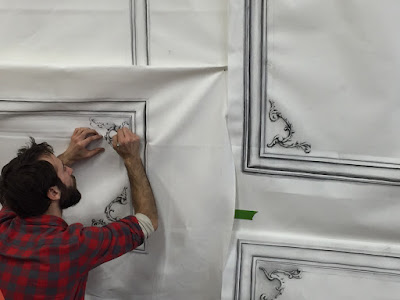| Wheeler Harrington House, Concord MA |
I was 7 years old in 1997 when my
mother and I left NY and moved to Concord, MA. We were
making a new start in the town of my mother’s ancestors. Being there felt like
home, and through this connection began my appreciation for Historic
Preservation. The many well preserved houses with plaques marking their
original inhabitant and construction date, invited onlookers to share in the
history of the structure. I would walk around town comparing the styles of
houses by decade, thinking of my ancestors who had walked these same paths,
their purpose and intentions made tangible in the landscape. From the dark
cramped attic of a Greek Revival home on Main Street, we made a new start as my
ancestors had. This is exactly the undertaking that I wish to pursue at Boston
University, to make a new start with a Masters in Preservation Studies, and to
fulfill a fascination that I have carried with me from my first years in
Concord.
In high school, I sought out as many courses in architecture, and specifically drafting, as I could. I wanted to be able to perfectly communicate my own ideas but also the proportions and motifs of historic architecture. This yen started with a drafting course at the high school, and later lead me to courses at Boston Architectural Center and Pratt. Though I received very good grades in these high school pre-college architecture programs, I settled on applying to a degree in set design from Purchase College, as I knew I could easily get in, and I did.
In high school, I sought out as many courses in architecture, and specifically drafting, as I could. I wanted to be able to perfectly communicate my own ideas but also the proportions and motifs of historic architecture. This yen started with a drafting course at the high school, and later lead me to courses at Boston Architectural Center and Pratt. Though I received very good grades in these high school pre-college architecture programs, I settled on applying to a degree in set design from Purchase College, as I knew I could easily get in, and I did.
It was the idea of designing sets for a specific time period that interested me most. I received high praises for my drafting skills and my abilities to compile meaningful design sources and research. What I did not conceive of at the time was the fact that those sets I would be designing are disposable and destined for the landfill. This is one of the reasons why Preservation Studies appeals to me now. The act of preservation seeks to keep intact what already exists and to only add missing items that will help to clarify the story of a building, it’s a sustainable practice that keeps buildings out of landfills and repurposes the structures for many useful years to come. I want to be a part of meaningful research that resurrects a building from the past, both from documentation and field study investigation techniques.
 |
| Felix in the Purchase College Design Tech Studio, 2008 |
It was the idea of designing sets for a specific time period that interested me most. I received high praises for my drafting skills and my abilities to compile meaningful design sources and research. What I did not conceive of at the time was the fact that those sets I would be designing are disposable and destined for the landfill. This is one of the reasons why Preservation Studies appeals to me now. The act of preservation seeks to keep intact what already exists and to only add missing items that will help to clarify the story of a building, it’s a sustainable practice that keeps buildings out of landfills and repurposes the structures for many useful years to come. I want to be a part of meaningful research that resurrects a building from the past, both from documentation and field study investigation techniques.
 |
| Felix working on the Club Monaco installation at Grand Central Terminal |
I have had the opportunity to employ research and detailed draftings in my work over the past few years, most notably on a fashion show in Grand Central Terminal for Club Monaco. My boss did not specify that I should use existing motifs from Grand Central, he asked me to simply “make it look Victorian”, but I couldn’t help myself from researching the rich vocabulary of neoclassical motifs in the Beaux-Arts building. The project consisted of a handful of kiosks, one of my kiosks was decorated with painted motifs and one was decorated with cotton rope. For the painted kiosk, I drafted a motif from a cast iron transom grill found above some of the platform entrances. I then transferred a full scale drafting of the motif and transferred the design to the kiosk using traditional scenic painting techniques. For the rope kiosk, I researched linear and twisting motifs that lent themselves to being constructed out of rope. The primary motif that I drew from is seen in the iron grille of the windows overlooking the main concourse. Working on this project helped me to understand a need I have to work with people who understand the importance of being specific within the design parameters of a particular style of architecture. It is at Boston University that I seek likeminded individuals within Preservation Studies to learn from and work with and put to greater use my knowledge and skills.
| Finished Club Monaco kiosk at Grand Central Terminal |
